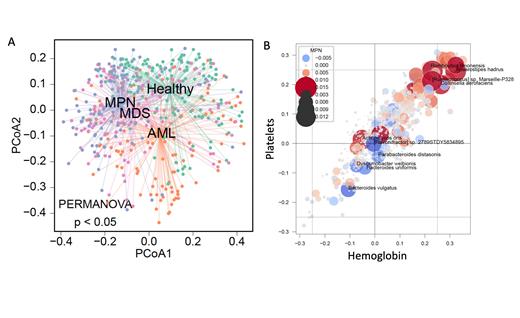Background
Deeper insights into somatic mutations have advanced our understanding of myeloid malignancies like Myelodysplastic Neoplasms (MDS), Myeloproliferative Neoplasms (MPN), and Acute Myeloid Leukemia (AML), particularly in terms of malignant clone interactions and immune dysregulation. However, the role of diverse extrinsic factors, such as gut microbial dysbiosis, in interacting with and modifying the microenvironment is still being studied. Here we analyzed gut microbial species and function in AML, MDS, and MPN patients, investigating correlation of disease metagenomic signatures with blood indices, somatic mutations, and disease subtype.
Methods
Fecal samples were collected from 337 Caucasian adult patients with MDS, MPN, and AML at Humanitas Research Hospital, Milan, Italy. Extracted DNA samples were sequenced (Illumina Novaseq 6000) and quality-trimmed data mapped against Integrated Gut Catalog (IGC2) using METEOR pipeline (Plaza Oñate et al., 2019). Human contaminant sequences were removed, and gene count tables were normalized according to the FPKM strategy using MOMR normFreqRPKM function.
Results
Overall 138 AML patients (63 females, 75 males, average age 62.3 ± 13.64); 93 MPN patients (29 females, 77 males, average age 66.3 ± 10.61) and 106 MDS patients (29 females, 77 males, average age 71.7 ± 10.87) were included. Concerning microbial richness we observed significantly lower richness and diversity in AML patients vs MDS or MPN. Principal Coordinates Analysis (PCoA) at the species level revealed significant differences in gut microbiomes among disease groups (PERMANOVA R2=7.38, p<0.001)(Figure 1A). AML and MDS shared seven depleted species, including three MetaGenomic Species (MGS) for Faecalibacterium prausnitzii, a key beneficial gut bacterium. Random Forest classification modelling to accurately identified AML, MDS, and MPN patients (AUCROC=0.91, 0.89, 0.85,MDS, AML, MPN respectively), with primary distinguishing features tied to increased levels of inflammation-inducing species. We further investigated mutation-specific microbiome signatures using Shannon Diversity:, JAK2 V617F mutated MPN had significantly greater diversity than MDS or AML (log2(MPN/AML)=0.28,p=7.7e-12, log2(MPN/MDS)=0.12,p=1.3e-9)). Additionally, within MDS, patients with SF3B1 mutation were significantly different from those with TP53 mutation (log2(SF3B1/TP53)=0.23,p=0.03)).
We conducted a correlation analysis with blood indices. Two depleted signatures in AML and MDS, butyrate producing species such as Faecalibacterium prausnitzii , positively correlated with platelets (rho=0.17,q=0.001) and hemoglobin (rho=0.23, q=1.7e-5). Conversely, enriched species like Erysipiclostridium ramosum showed a negative correlation with hemoglobin (rho=-0.23,q=1.26e-5), and platelet count (rho=-0.17,q=0.002) in AML and MDS. Notably, in MPN, the pattern was reversed; depleted species like Flavonifractor plautii were negatively correlated with hemoglobin (rho=-0.15,p=0.004) and platelet count (rho=-0.19,q=0.4e-3)). (Figure 1B).
We compared microbiome signatures at diagnosis and disease relapse in 94 patients with MDS/AML treated with hypomethylating-based therapies. A significant reduced taxonomical abundances was found in samples collected at disease relapse with respect to those from the same subject at diagnosis (p<0.001). Finally, in 133 MDS/AML patients who underwent disease modifying treatment at diagnosis, we evaluate the incidence of severe infections and the possible associations with specific microbiome signatures. We noticed that patients who developed a severe infection (G3-G4) showed a significantly reduced taxonomical abundances in gut microbiome (as evaluated at disease diagnosis before treatment) with respect to those subject who didn't experience relevant infectious complications (P<.001)
Conclusion
Our study reveals striking correlations between gut microbiome and clinical/genetic features of AML, MDS, and MPN, suggesting gut microbiome as potential disease markers and therapeutic targets. This enhances our grasp of myeloid malignancies' pathophysiology, setting the stage for further investigations into the intricate interaction between the gut microbiome, genetic mutations, and clinical traits in these conditions, potentially leading to the development of microbiome-focused therapies.
Disclosures
Harrison:Galecto: Honoraria, Speakers Bureau; GSK: Honoraria, Speakers Bureau; CTI: Honoraria, Speakers Bureau; Abbvie: Honoraria, Speakers Bureau; AOP: Honoraria, Speakers Bureau; Morphosys: Honoraria, Speakers Bureau; Novartis: Honoraria, Research Funding, Speakers Bureau; BMS: Honoraria, Speakers Bureau. Kordasti:Beckman Coulter: Honoraria; MorphoSys: Research Funding; Novartis: Honoraria, Membership on an entity's Board of Directors or advisory committees. Della Porta:Bristol Myers Squibb: Honoraria, Membership on an entity's Board of Directors or advisory committees. Shoaie:Bash Biotech: Current equity holder in private company; Gigabiome: Current equity holder in private company.


This feature is available to Subscribers Only
Sign In or Create an Account Close Modal